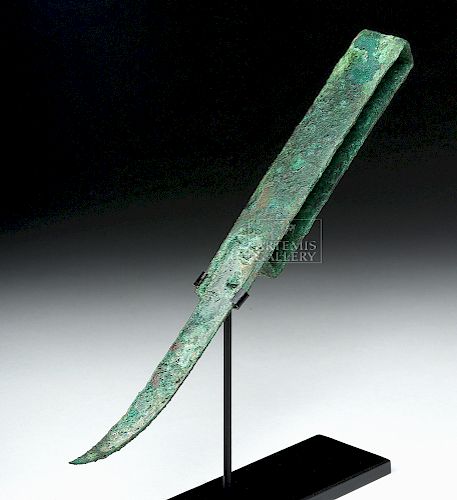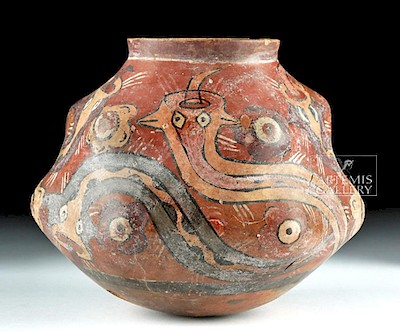Roman Bronze Strigil - Rare Form
Lot 53
About Seller
Artemis Gallery
686 S Taylor Ave, Ste 106
Louisville, CO 80027
United States
Selling antiquities, ancient and ethnographic art online since 1993, Artemis Gallery specializes in Classical Antiquities (Egyptian, Greek, Roman, Near Eastern), Asian, Pre-Columbian, African / Tribal / Oceanographic art. Our extensive inventory includes pottery, stone, metal, wood, glass and textil...Read more
Categories
Estimate:
$1,800 - $2,700
Absentee vs Live bid
Two ways to bid:
- Leave a max absentee bid and the platform will bid on your behalf up to your maximum bid during the live auction.
- Bid live during the auction and your bids will be submitted real-time to the auctioneer.
Bid Increments
| Price | Bid Increment |
|---|---|
| $0 | $25 |
| $300 | $50 |
| $1,000 | $100 |
| $2,000 | $250 |
| $5,000 | $500 |
| $10,000 | $1,000 |
| $20,000 | $2,500 |
| $50,000 | $5,000 |
| $100,000 | $10,000 |
| $200,000 | $20,000 |
About Auction
By Artemis Gallery
Jul 5, 2018
Set Reminder
2018-07-05 10:00:00
2018-07-05 10:00:00
America/New_York
Bidsquare
Bidsquare : Ancient | Ethnographic | Fine Art
https://www.bidsquare.com/auctions/artemis-gallery/ancient-ethnographic-fine-art-3306
Featuring classical antiquities, ancient and ethnographic art from cultures encompassing the globe. Artemis Gallery info@artemisgallery.com
Featuring classical antiquities, ancient and ethnographic art from cultures encompassing the globe. Artemis Gallery info@artemisgallery.com
- Lot Description
Roman, Imperial Period, ca. 1st to 3rd century CE. An elegant and simple bronze strigil with a narrow, concave blade that gently curves and tapers to a sharpened point. The blade straightens out to a flattened handle that folds over and meets the base of the scoop. The rectangular handle would allow the user to easily maneuver the blade when in use, and enabled it to be suspended on a hook or small peg when not in use. The entire tool is covered in thick areas of pale-green, dark-green, and russet-hued patina. Typical strigils do not have pointed blades but rather curved ends and more-pronounced bending to the blade portion. The sharpened tip and slender blade profile make this an exceptionally rare example. Custom museum-quality display stand included. Size: 8.375" L (21.3 cm); 6.375" H (16.2 cm) on included custom stand.
The strigil was a scraper used in combination with olive oil and sand or pumice to exfoliate the skin after exercising or bathing. It was an essential piece of equipment for the Greek and Roman athlete, and as such came to symbolize athleticism itself. Greek vases abound with depictions of youthful athletes using strigils in the gymnasium. The celebrated sculpture by Lysippos, the Apoxyomenos of ca. 350 to 325 BCE, depicted a nude athlete scraping himself off with a strigil. The Romans adopted the strigil not only among the athletes in the paelestra but also among the patrons of the public baths.
Provenance: ex-private Cypress, Texas, USA collection
All items legal to buy/sell under U.S. Statute covering cultural patrimony Code 2600, CHAPTER 14, and are guaranteed to be as described or your money back.
A Certificate of Authenticity will accompany all winning bids.
We ship worldwide and handle all shipping in-house for your convenience.
#132719Surface wear commensurate with age and use, slight bending to overall form, small nicks to handle and blade portion, otherwise intact and excellent. Nice earthen deposits and lovely light-green, dark-green, and russet patina throughout.Condition
- Shipping Info
-
All shipping is handled in-house for your convenience. Your invoice from Artemis Gallery will include shipping calculation instructions. If in doubt, please inquire BEFORE bidding for estimated shipping costs for individual items.
-
- Buyer's Premium



 EUR
EUR CAD
CAD AUD
AUD GBP
GBP MXN
MXN HKD
HKD CNY
CNY MYR
MYR SEK
SEK SGD
SGD CHF
CHF THB
THB















